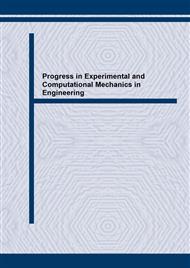[1]
Hubbert, M.K. and Willis, D.G. 1957. Mechanics of hydraulic fracturing, Trans. AIME 210, 153-166.
DOI: 10.2118/686-g
Google Scholar
[2]
Degue, K.M. and Ladanyi, B. 2000. Effect of fluid penetration and pressurizing rate on hydraulic fracturing. Pacific Rocks 2000, Girad, Liebman, Breeds and Doe (eds), Balkema, Rotterdam. 181-188.
Google Scholar
[3]
Lockner D. and Byerlee, J.D. 1977. Hydrofracture in Weber sandstone at high confining pressure and differential stress. Journal of Geophysical Research, 82(14), 2018-2026.
DOI: 10.1029/jb082i014p02018
Google Scholar
[4]
Zoback, M.D. and Pollard, D.D. 1978. Hydraulic fracture propagation and the interpretation of the pressure-time records for In-situ stress determination. 19th U.S. Rock Mechanics Symposium, Stateline, Nevada, 14-22
Google Scholar
[5]
Rummel, F. 1987. Fracture mechanics approach to hydraulic fracturing stress measurements, Fracture Mechanics of Rock (B. Atkinson, ed.). Academic Press, New York. 217-239.
DOI: 10.1016/b978-0-12-066266-1.50011-9
Google Scholar
[6]
Yale, D.P. Lyons, S.L. and Qin, G. 2000. Coupled geomechanics-fluid flow modeling in petroleum reservoirs: coupled versus uncoupled response. Pacific Rocks 2000, Girard, Liebman, Breeds & Doe (eds), Belkema, Rotterdam, 137-144.
Google Scholar
[7]
Morale, R.H. and Abou-Sayed, A.S. 1989. Microcomputer analysis of hydraulic fracture behaviour with a pseudo-three-dimensional simulator. SPE Production Engineering 4, 69-74.
DOI: 10.2118/15305-pa
Google Scholar
[8]
Advani, S.H., Lee, T.S. and Lee, J.K. 1990. Three-dimensional modeling of hydraulic fracture in layered media. ASME Journal Energy Resources Technology 112, 1-9.
Google Scholar
[9]
Kim, K. and Yao, C.Y. 1994. The influence of constitutive behaviour on the fracture process zone and stress field evolution during hydraulic fracturing. Rock Mechanis, Nelson & Laubach (eds), Balkema, Rotterdam, 193-200.
Google Scholar
[10]
Tang, C.A., Yang, T.H., Li, L.C., Tham, L.G. and Lee, K.K., Coupled analysis of flow, stress and damage (FSD) in rock failure - Part I: Fundamentals, Submitted to Int. J. Rock Mech. Min. Sci.
DOI: 10.1016/s1365-1609(02)00023-0
Google Scholar
[11]
Tang C.A. Numerical simulation of progressive rock failure and associated seismicity. Int. J. Rock Mech. Min. Sci. 1997; 34(2): 249-262
DOI: 10.1016/s0148-9062(96)00039-3
Google Scholar
[12]
Keivan NoghabaiˈDiscrete versus Smeared versus Element-Embedded Crack Models on Ring Problem, JOURNAL OF ENGINEERING MECHANICSˈJUNE 2000ˈ307-314ˊ
Google Scholar
[13]
Charlez P.A. 1991. Rock Mechanics (II: Petroleum applications) Fig.1 Sample geometry for simulating hydraulic fracturing D=312mm d=36mm dH dV 1p 6 a. Maximum principal stress b. Minimum principal stress Fig2 Numerically obtained stress fields in simple with homogeneity index m=1.5 (step 10). a. Pu=5.0MPa, Lu=69.9mm(Step 50-1) b. stress field (Step 50-12) c flow rate (Step 50-15) Fig. 3 Numerically obtained evolution of stress field and flow rate during hydraulic fracturing process in sample with homogeneity index m=1.5 Fig.4 Influence of heterogeneity on AE counts and borehole diameter variation(m=1.5) i b L 0 100 200 300 400 500 600 1 21 41 61 81 Step (*0.1 MPa) AE Counts 0 0.01 0.02 0.03 0.04 0.05 0.06 Elongation (mm) AE Elongation-V Elongation-H
Google Scholar


